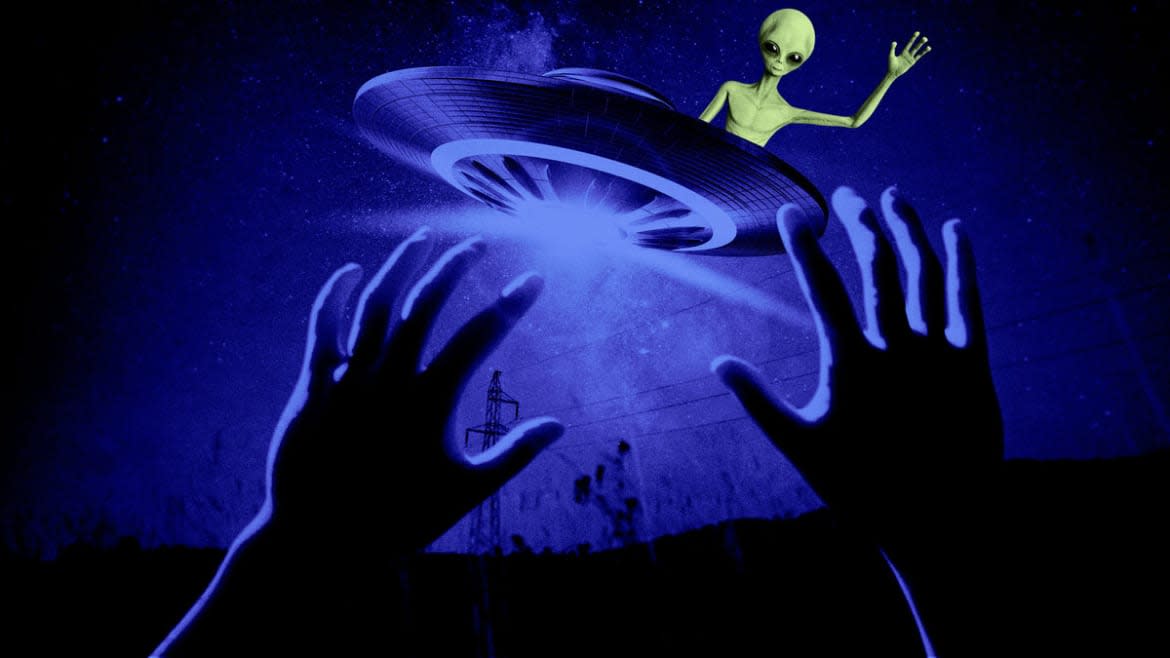NASA Should Just Say It: We’re Looking for Goddamn Aliens

The great American UFO hunt is on—and NASA is officially throwing its hat in the ring. The agency announced last week that it’s launching a nine-month study into unidentified aerial phenomena (UAP), the U.S. government’s preferred term for UFOs. The project itself is a “scientific pursuit,” according to an agency press release, with the goal of identifying and aggregating specific pieces of data that could be used as part of a future research project into the origins of UAP. When the UAP study concludes, the results will be made available for the public. That will include public hearings as well as comment sessions about the findings.
“This is the first step with any scientific experiment to identify what data we could possibly use to shed further light on the question of UAPs,” Daniel Evans, the assistant deputy associate administrator for research at NASA’s Science Mission Directorate, told The Daily Beast. Evans is also the designated federal official who’s responsible for appointing and organizing the experts who will take part of the committee.
“We’re assembling a team of truly some of the world’s leading scientists, data practitioners, and aeronautics experts,” he added. “We’re going to lean on their collective expertise to tell us what data exists out there that we could positively use to shed further light on UAP.”
The study is notable for a number of reasons—the biggest perhaps being that it’s the first ever official NASA study into UAPs. It’s also the first instance where the agency has said that it’s open to the possibility that UFOs are evidence of intelligent alien life. In both the press release and the conference held last week, the agency made a point to mention that they were already undertaking several efforts to find extraterrestrial life—but then went on to stress that this study wasn’t explicitly to find evidence of extraterrestrials visiting our planet. It’s the kind of bureaucratic vaguebooking expected from a government entity like NASA—especially when it comes to anything concerning aliens and UFOs.
NASA has had a long history of being intensely skittish when it comes to extraterrestrial matters. After all, aliens have long been the bread and butter of conspiracy theorists, long-winded AM radio hosts, and sensational tabloid covers. When your organization wants to maintain a reputation of authority and reliability in the realm of science and technology, you wouldn’t want to touch something like UFOs with a 10-foot pole—especially since your funding is tied to congressional members who expect taxpayer dollars to go towards actual science and not conspiracy theories about little green men.
But times have changed. The U.S. government has begun the slow rollout of UAP research and reports in recent years. Members of Congress have even announced their support of UFO research in the interest of national security. The Pentagon has even established a permanent UAP office along with a string of reports last year. These moves might have been enough for NASA to finally get a little less nervous about looking into UFOs.
But the bad news for anyone who’s hoping NASA will provide irrefutable evidence of visitors from other planets is that the study’s scope is going to be fairly limited. In fact, it’s mostly going to be spent listening to a panel of experts who will be tasked with identifying and collecting data such as satellite imagery that could potentially contain footage of UAP.
No, You Gullible Fools. The UFOs Aren’t Aliens.
“There’s no analysis,” Evans explained. “It’s just to have the experts tell us what data we should use in the future to better study UAP.” So it’s important work, especially when you consider that it’s laying the groundwork for a future program to study the origins of UAPs. It just may not be the ET hunt some might hope for.
But remember: NASA and its scientists are not ruling the potential for aliens out. The future UAP program does promise to be a deep dive into the origins of certain alleged extraterrestrial phenomena. No doubt, many hope that it’s going to reveal something about potential alien life.
Regardless of what it finds, the agency is risking a lot by even wading into UFO discourse. NASA isn’t just staking its reputation with this study; it’s also putting taxpayer funding on the line. Evans believes this kind of risk needs to be embraced in the scientific community, since risky endeavors are how tech advancements occur and how some of the world’s most groundbreaking discoveries are made.
The Alien Hunter’s Playbook Is Getting a Cutting-Edge Rewrite
“We’re really trying to encourage people to take intellectual risks and recognize that it might not always pay off,” said Evans, who views the UAP study as yet another example of high-risk, high-reward research. “We actually want failure because we want people to lean forward and not do incremental science. We may very well fail—but that’s OK, because we’ll learn.”
Incidentally, though, the biggest risk NASA could possibly take as part of this study would be to stop hedging and finally say it: We’re trying to find out if these UFOs are aliens. The American public, Congress, and the Department of Defense are all primed and ready for this. There’s no need for mealy-mouthed excuses and justifications for a UAP study.
Regardless of how explicit the agency plans to be about its goals for the UAP study, it’s taking a giant leap into unraveling the enigmatic origins of UFOs—and getting us closer to finally answering whether or not the truth is out there.
“It’s going to be a ton of fun,” Evans said. “I’m really excited about doing this.”
Got a tip? Send it to The Daily Beast here
Get the Daily Beast's biggest scoops and scandals delivered right to your inbox. Sign up now.
Stay informed and gain unlimited access to the Daily Beast's unmatched reporting. Subscribe now.


